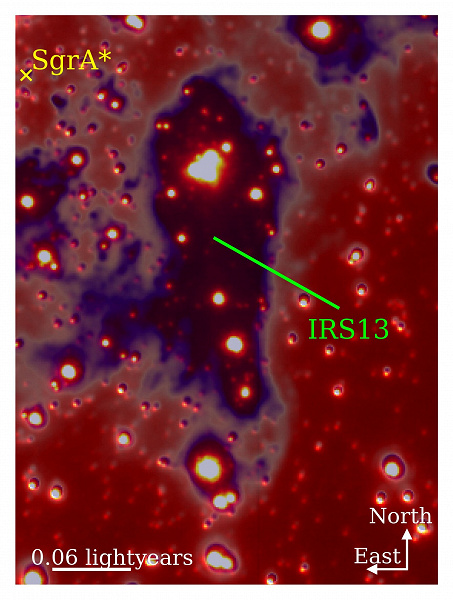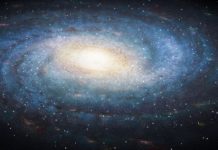Astrophysicists have discovered that the young star cluster IRS13 near the supermassive black hole Sagittarius A* is much younger than expected. The IRS13 cluster migrated to the black hole due to friction with the interstellar medium and collisions with other clusters
An international team led by Dr. Florian Peisskei from the Institute of Astrophysics at the University of Cologne has studied in detail a young star cluster near the supermassive black hole Sagittarius A* (Sgr A*) at the center of our galaxy and found that it is much younger than previously estimated.
This cluster, known as IRS13, was discovered more than twenty years ago, but only now has it been possible to identify its components in detail by combining a wealth of data collected using different telescopes over several decades. The stars inside the cluster are several hundred thousand years old—they are extremely young by the standards of stellar life. For comparison, our Sun is about 5 billion years old. The galaxy’s high-energy radiation and tidal forces make it surprising to have so many young stars near a supermassive black hole.

Young stars near a black hole: the mystery of the IRS13 star cluster near Sagittarius A*
The study used observations from the James Webb Space Telescope (JWST) to record a spectrum free from interference from the galactic center. This spectrum reveals the presence of water ice in the galactic center. This water ice, which is often found in dusty disks around very young stars, was another independent indicator of the youth of some stars near the black hole.
In addition to JWST’s unexpected discovery of young stars and water ice, the researchers also discovered that IRS13 has a turbulent formation history. The results of the study suggest that IRS13 migrated to the supermassive black hole under the influence of friction with the interstellar medium, collisions with other star clusters, or internal processes. And then this star cluster was attracted by the gravity of the black hole.
The process also created a compacted formation at the “top” of the cluster due to the dust surrounding the cluster. The increase in dust density stimulated further star formation. This explains why young stars are found mostly at the “top” or front of the cluster.
“The analysis of IRS13 and interpretation of the history of this cluster is the first attempt to resolve a decades-old mystery about unexpectedly young stars at the galactic center. In addition to IRS13, there is another star cluster – the so-called S-cluster, which is even closer to the black hole and also consists of young stars. They are also much younger than is possible according to accepted theories,” says Dr. Paisskea.
The results obtained about the IRS13 star cluster provide an open opportunity for further studies of the relationship between proximity to the black hole and regions several light years away. The second author of the study, Dr Mišal Zajaček from Masaryk University in Brno (Czech Republic), added: “The IRS13 star cluster appears to hold the key to the origin of the dense stellar population at the center of our galaxy. We have collected extensive evidence that very young stars within the range of a supermassive black hole could form in star clusters such as IRS13. This is also the first time we have been able to identify stellar populations of different ages – hot main sequence stars and young embryonic stars in a cluster so close to the center of the Milky Way.”




